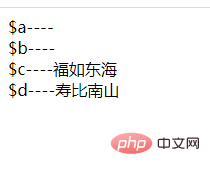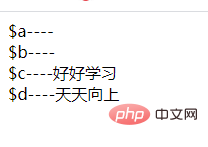Learn to use PHP's List, each function and their coordination
In the previous article, I brought you "How to get PHP super global variables (organizing and sharing)". This article introduces the relevant knowledge of super global variables in PHP in detail. This article In this article, let’s take a look at the relevant knowledge of list and each functions in PHP to traverse arrays. I hope it can help everyone!

#The list function and each function are functions that we often use in our daily life, so how should we use these two functions? What are the characteristics between the two? How do they work together? These two functions are interesting array functions. It is not difficult to learn the functions, so let’s take a look.
list function
list function its function is: it can download the index array The one marked with 0 corresponds to variable 1, and the one with subscript 1 corresponds to variable 2... The list function can turn the elements of the array into variables.
Its basic syntax is:
list(变量1,变量2...)
The example is as follows:
<?php list($a , $b , $c, $d) = array('好好学习' ,'天天向上' ,'福如东海','寿比南山'); echo '$a----'.$a.'<br />'; echo '$b----'.$b.'<br />'; echo '$c----'.$c.'<br />'; echo '$d----'.$d.'<br />'; ?>
Output result:

It can be seen from this that the subscript of "study well" in the array is 0, which corresponds to $a in the list function; it can also be understood as the assignment of "study well" with a variable of 0 in the array $a in the list function is given; and so on. The list is from left to right, one-to-one corresponding to the subscript value starting from 0 in the index array.
At the same time, there is another situation, the example is as follows:
<?php list( , , $c, $d) = array('好好学习' ,'天天向上' ,'福如东海','寿比南山'); echo '$a----'.$a.'<br />'; echo '$b----'.$b.'<br />'; echo '$c----'.$c.'<br />'; echo '$d----'.$d.'<br />'; ?>
Output result:

In the above example, the subscript The value of Fu Rudonghai of 2 is assigned to $c, and the first two positions in the list are left empty, which corresponds to one-to-one, so study hard and Tiantianxiang have no corresponding variables. Therefore, the list function strictly adheres to the one-to-one correspondence principle, that is, the first variable of the list function corresponds to the element with the subscript 0 in the array, the subscript 1 corresponds to the second variable in the list function, and so on. .
Of course there is another situation, the example is as follows:
<?php list($a , $b , $c, $d) = array(2=>'好好学习' ,'天天向上' ,'福如东海','寿比南山'); echo '$a----'.$a.'<br />'; echo '$b----'.$b.'<br />'; echo '$c----'.$c.'<br />'; echo '$d----'.$d.'<br />'; ?>
Output result:

In In the above example, because the key name of the array starts directly from 2, there are no elements with subscripts 0 and 1 in the array elements, so the variables a and b have no corresponding values. At the same time, only four variables are written in the list function, and Fu Rudonghai and Shoubi Nanshan with subscripts 4 and 5 in the array elements have no corresponding variables.
each function
##eachThe function of the function is to pass in an array. It will split one of the elements into a new array. Do this one element at a time. Move once and operate the next array element in the same way. Execute to the end and return false.
<?php $a=[ 'aaa'=>'好好学习', 'bbb'=>'天天向上', 'ccc'=>'福如东海', 'ddd'=>'寿比南山' ]; //第一次each $data = each($a); echo '<div class="code" style="position:relative; padding:0px; margin:0px;"><div class="code" style="position:relative; padding:0px; margin:0px;"><div class="code" style="position:relative; padding:0px; margin:0px;"><pre class="brush:php;toolbar:false">'; var_dump($data); echo '

<?php $a=[ 'aaa'=>'好好学习', 'bbb'=>'天天向上', 'ccc'=>'福如东海' ]; //第一次each $data = each($a); echo '<div class="code" style="position:relative; padding:0px; margin:0px;"><div class="code" style="position:relative; padding:0px; margin:0px;"><div class="code" style="position:relative; padding:0px; margin:0px;"><pre class="brush:php;toolbar:false">'; var_dump($data); echo '
'; var_dump($data); echo '
'; var_dump($data); echo '
'; var_dump($data); echo '

The cooperation between list and each
<?php $a=[ 'aaa'=>'好好学习', 'bbb'=>'天天向上', 'ccc'=>'福如东海', ]; list($key,$value) = each($a); echo $key. '-----' .$value .'<br />'; ?>

<?php
$a=[
'aaa'=>'好好学习',
'bbb'=>'天天向上',
'ccc'=>'福如东海',
];
while(list($key,$value) = each($a)){
echo $key. '-----' .$value .'<br />';
}
?>
It can be seen from the above results that each loop is executed once, and then one element is moved backward. At the end of the execution, the flash is returned to stop the loop.
Recommended learning: "PHP Video Tutorial"
The above is the detailed content of Learn to use PHP's List, each function and their coordination. For more information, please follow other related articles on the PHP Chinese website!

Hot AI Tools

Undresser.AI Undress
AI-powered app for creating realistic nude photos

AI Clothes Remover
Online AI tool for removing clothes from photos.

Undress AI Tool
Undress images for free

Clothoff.io
AI clothes remover

Video Face Swap
Swap faces in any video effortlessly with our completely free AI face swap tool!

Hot Article

Hot Tools

Notepad++7.3.1
Easy-to-use and free code editor

SublimeText3 Chinese version
Chinese version, very easy to use

Zend Studio 13.0.1
Powerful PHP integrated development environment

Dreamweaver CS6
Visual web development tools

SublimeText3 Mac version
God-level code editing software (SublimeText3)

Hot Topics
 1657
1657
 14
14
 1415
1415
 52
52
 1309
1309
 25
25
 1257
1257
 29
29
 1229
1229
 24
24
 PHP 8.4 Installation and Upgrade guide for Ubuntu and Debian
Dec 24, 2024 pm 04:42 PM
PHP 8.4 Installation and Upgrade guide for Ubuntu and Debian
Dec 24, 2024 pm 04:42 PM
PHP 8.4 brings several new features, security improvements, and performance improvements with healthy amounts of feature deprecations and removals. This guide explains how to install PHP 8.4 or upgrade to PHP 8.4 on Ubuntu, Debian, or their derivati
 How do you parse and process HTML/XML in PHP?
Feb 07, 2025 am 11:57 AM
How do you parse and process HTML/XML in PHP?
Feb 07, 2025 am 11:57 AM
This tutorial demonstrates how to efficiently process XML documents using PHP. XML (eXtensible Markup Language) is a versatile text-based markup language designed for both human readability and machine parsing. It's commonly used for data storage an
 Explain JSON Web Tokens (JWT) and their use case in PHP APIs.
Apr 05, 2025 am 12:04 AM
Explain JSON Web Tokens (JWT) and their use case in PHP APIs.
Apr 05, 2025 am 12:04 AM
JWT is an open standard based on JSON, used to securely transmit information between parties, mainly for identity authentication and information exchange. 1. JWT consists of three parts: Header, Payload and Signature. 2. The working principle of JWT includes three steps: generating JWT, verifying JWT and parsing Payload. 3. When using JWT for authentication in PHP, JWT can be generated and verified, and user role and permission information can be included in advanced usage. 4. Common errors include signature verification failure, token expiration, and payload oversized. Debugging skills include using debugging tools and logging. 5. Performance optimization and best practices include using appropriate signature algorithms, setting validity periods reasonably,
 Explain late static binding in PHP (static::).
Apr 03, 2025 am 12:04 AM
Explain late static binding in PHP (static::).
Apr 03, 2025 am 12:04 AM
Static binding (static::) implements late static binding (LSB) in PHP, allowing calling classes to be referenced in static contexts rather than defining classes. 1) The parsing process is performed at runtime, 2) Look up the call class in the inheritance relationship, 3) It may bring performance overhead.
 PHP Program to Count Vowels in a String
Feb 07, 2025 pm 12:12 PM
PHP Program to Count Vowels in a String
Feb 07, 2025 pm 12:12 PM
A string is a sequence of characters, including letters, numbers, and symbols. This tutorial will learn how to calculate the number of vowels in a given string in PHP using different methods. The vowels in English are a, e, i, o, u, and they can be uppercase or lowercase. What is a vowel? Vowels are alphabetic characters that represent a specific pronunciation. There are five vowels in English, including uppercase and lowercase: a, e, i, o, u Example 1 Input: String = "Tutorialspoint" Output: 6 explain The vowels in the string "Tutorialspoint" are u, o, i, a, o, i. There are 6 yuan in total
 What are PHP magic methods (__construct, __destruct, __call, __get, __set, etc.) and provide use cases?
Apr 03, 2025 am 12:03 AM
What are PHP magic methods (__construct, __destruct, __call, __get, __set, etc.) and provide use cases?
Apr 03, 2025 am 12:03 AM
What are the magic methods of PHP? PHP's magic methods include: 1.\_\_construct, used to initialize objects; 2.\_\_destruct, used to clean up resources; 3.\_\_call, handle non-existent method calls; 4.\_\_get, implement dynamic attribute access; 5.\_\_set, implement dynamic attribute settings. These methods are automatically called in certain situations, improving code flexibility and efficiency.
 PHP and Python: Comparing Two Popular Programming Languages
Apr 14, 2025 am 12:13 AM
PHP and Python: Comparing Two Popular Programming Languages
Apr 14, 2025 am 12:13 AM
PHP and Python each have their own advantages, and choose according to project requirements. 1.PHP is suitable for web development, especially for rapid development and maintenance of websites. 2. Python is suitable for data science, machine learning and artificial intelligence, with concise syntax and suitable for beginners.
 PHP: A Key Language for Web Development
Apr 13, 2025 am 12:08 AM
PHP: A Key Language for Web Development
Apr 13, 2025 am 12:08 AM
PHP is a scripting language widely used on the server side, especially suitable for web development. 1.PHP can embed HTML, process HTTP requests and responses, and supports a variety of databases. 2.PHP is used to generate dynamic web content, process form data, access databases, etc., with strong community support and open source resources. 3. PHP is an interpreted language, and the execution process includes lexical analysis, grammatical analysis, compilation and execution. 4.PHP can be combined with MySQL for advanced applications such as user registration systems. 5. When debugging PHP, you can use functions such as error_reporting() and var_dump(). 6. Optimize PHP code to use caching mechanisms, optimize database queries and use built-in functions. 7




